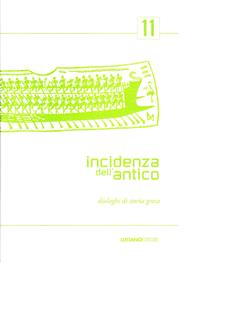- ISSN: 1971-2995
- Pagine: 208
- Abbrevazione assegnata da l'Année Philologique: IncidAntico
- Editore: Luciano Editore, Napoli
Contenuti:
The paper is the second part of a study on the Greek sanctuary of Nemea and it is focused on the Hellenistic and Roman periods. It includes a detailed analysis of thearchaeological, epigraphic and literary evidence and methodological remarks on the different value of each kind of ‘documents’ in the reconstruction of the life of an ancient Greek sanctuary. The main questions which are dealt with in this study are the following: 1. the return of the games from Argos to Nemea in the last third of the IVth c. BC. 2. The final abandonment of Nemea as the seat of the games during the IIIrd c. BC. and the survival of the sanctuary as far as other activities were concerned. 3. The editions of the games which were held occasionally in Nemea in the IIIrd and IInd centuries BC and the meaning of such initiatives. 4. Nemea during the Roman period..
Nemea | Panhellenic sanctuaries and festivals | Argos | Cleonae | Achaean league
This paper aims at exploring the function and significance of the lead tablets found during the archaeological excavations at Dodona. Through the study of the literary and epigraphic evidence, testifying consultations of the oracle, it emerges strikingly that no literary source mentions patently the involvement of the lead tablets in the divination practice, but plenty of literary evidence attest several other different divination systems. Moreover, the oracular questions document an extreme variety of formulae used, which do not hint at any precise oracular code to address the god(s). These considerations induce to suggest that the lead tablets at Dodona might have worked only as a memory of the presence of the devotees in the shrine.
Dodona | oracle | divination practice | memories | ancient pilgrimage
The paper discusses ancient and modern localizations of the Arimi’s land. It is argued that Hesiod imagined it in the West, perhaps at Pithecusa, also on the basis of the match of meaning between the Etruscan ‘Arimos’ and the Greek ‘Pithekos’. As for the Pandora’s crown, as described by Hesiod, it has no correspondence in the archaeological Realien. Through the hideous and hybrids creatures that decorated it, the poet anticipates the diffusion of this kind of representations, distinctive of the Orientalizing period.
Hesiod | Arimi | Typhon | Pithecusa | Pandora
This paper considers the excerpt from the book V of Aristotle’s Politics concerning the most important cause that may lead democracies to ruin, namely the shameless attitude of the prostatai tou demou. The analysis aims: (a) to identify the complex dynamics in the relations of cause and effect between the impudent behaviour of demagogues and socio-constitutional changes of the poleis where they act; (b) to read the excursus on demagoguery as partially independent from theoretical statement; (c) to understand its peculiar meaning in view of other texts, that are complementary to the subject but non parallel.
Aristotle | democracy | constituional changes | argumentative 'frame' | demagogues
Few tyrants died a natural death: most of them were killed and some were murdered by a woman. Four interesting cases (Xenocrites, Thebe, Erisso and Aretephila) show how a tyrannicide woman used to act, who helped her, which were the outcomes and who finally held the power. These feminine deeds are modelled on a pattern clearly influenced by a gender approach.
Greek history | tyrants | tyrant's death | women | feminine power
The aim of this paper is to outline the historical life of one of the most interesting characters in the history of Alexander the Great: Memnon of Rhodes. My purpose is to make a painting, the most exhaustive possible, not only of the events in which the lives of the two characters were intertwined, from the battle of the Granicus, but also to rebuild the period, less known, which preceded the battle against Alexander.
Memnon of Rhodes | Alexander the Great | Darius III | Granicus | Mentor
The relief medaillon of a guttus in Berlin can lively illustrate the receptivity, in the southern part of the Italic peninsula, and particularly in northern/middle Apulia, of the most innovative tendencies to be found in late Classical and early Hellenistic sculpture and Kleinkunst, and possibly even connections with works of ‘dynastic’ inspiration from Greece and Magna Graecia. A tentative comparison is made with the situation in contemporary Etruscan major sculpture.
Minor Arts | Greece | Magna Graecia | Etruria | Late Classical and Hellenisti Age
Informazioni
Incidenza dell'Antico
incidenzadellantico@gmail.com
Edizioni ETS
Lungarno Mediceo, 16 - 56127 Pisa (PI), Italia
info@edizioniets.com www.edizioniets.com
Abbonamenti
Individuale
Italia: € 50,00
Europa: € 50,00
Mondo: € 60,00
Online: € 30,00
Cartaceo + online: € 80,00
Istituzionale
Italia: € 55,00
Europa: € 55,00
Mondo: € 65,00
Online: € 40,00
Cartaceo + online: € 95,00
© 2025 Incidenza dell'Antico - mail: incidenzadellantico@gmail.com
